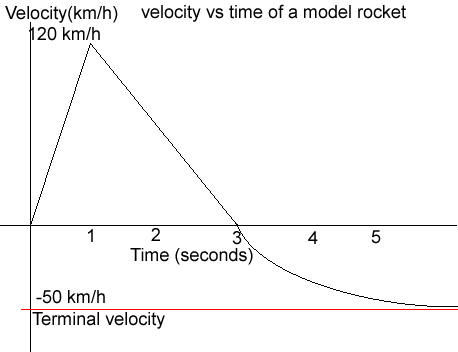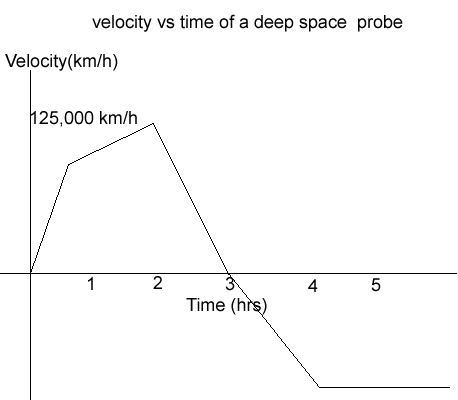Forces during flight
When a force acts on an object it tends to change its velocity, shape or direction. The closest we can come to a real rocket launch is a model rocket. It stands motionless on the launch pad with zero velocity. All of a sudden the solid engine ignites and in just 2 seconds it is travelling at 120 km/h. The force created by the engine (thrust) accelerated the rocket by changing its velocity, from 0 km/h to 120 km/h in just 2 seconds.
You
see acceleration is the change in velocity. During acceleration velocity
increases, while during deceleration velocity decreases.
Consider the velocity time-time graph of a model rocket.

The graph tells us a great deal of information. Lets see.
Over the first second of flight the rocket accelerates from 0 to 120 km/h. After one second the fuel runs out and the rocket slows down, decelerates, from 120 km/h to 0 km/h in two seconds, while it is still climbing to its maximm height. As the rocket starts to fall its velocity is shown on the graph as being negative. A negative velocity tells us the rocket is travelling in the opposite direction to where it was once travelling. After 5 seconds the rocket reaches its maximum velocity as it is falling. We call this terminal velocity. It is the maximum speed reached by a falling object as wind resistance prevents it going any faster. Sometimes we use a parachute to increase the air resistance of a falling object and therefore lower its terminal velocity.
Consider a space craft in deep space. Without a force acting on it there would be no acceleration. The greater the force the greater the acceleration. Look at the velocity-time graph of a deep space probe.

Lets see what we can learn from this graph. The velocity changes quickly over the first hour when compared to the change in velocity over the second hour. Acceleration is greatest over the first hour than the second hour. The force acting on the probe is less during the second hour. May be the probe's computer decreased the thrust of the engines during the second hour of travel. The space probe slows down after two hours of travel. It is obvious that the probe has encountered a force that is slowing it down. May its engines were programmed to go on reverse thrust slowing the probe down and after three hours the probe is accelerating backwards. Four hours into the flight the probe is travelling at constant velocity backwards. There is no acceleration and so there is no force acting on the probe after four hours.
Tests of a new rocket engine are conducted. The rocket is launched straight
up and data collected by computers and displayed as graphs. As the engineer
in charge of evaluating the new engine, you are handed a graph of speed
versus time. You take the graph and go into the office of the chief engineer
to discuss the results.

Answer the Chief’s questions
1) For how many minutes did the fuel last for?
2) How many minutes after launch did the rocket reach peak altitude?
3) How long did the rocket take to return back to earth?
4) Did the parachutes open or did the rocket crash?
5) At what speed did the rocket return back to earth?
6) Between 2 and 4 minutes the rocket is decelerating. What force/s cause
the deceleration?
Another rocket was tested and the following velocity-time graph obtained.

1) For how many minutes did the fuel last for?
2) How many minutes after launch did the rocket reach peak altitude?
3) How long did the rocket take to return back to earth?
4) Did the parachutes open or did the rocket crash?
5) At what speed did the rocket return back to earth?
6) Does this rocket engine produce a greater thrust than the engine tested
above? Explain why.